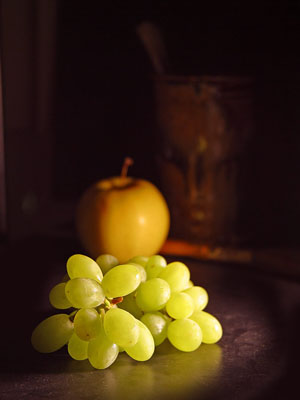Composition is a critical element of still-life work. The subjects themselves may be ordinary everyday items but the photographer must ensure that the various forms, colours and textures are arranged in an interesting and engaging manner. A number of guidelines can of course be identified, but it is the creativity and skill of the photographer that makes the difference between the mundane and the extraordinary.
 |
| Public domain image |
One might begin by considering the nature of the subject, their potential uses and how they might be shown in an appropriate context. Never overlook the reason the picture is being created, and hence whether key requirements are being met. Also consider a few of the well-used guidelines such as the rule of thirds, the use of leading lines, combining pyramids, or frames within frames. All these classical ideas have merit but the photographer must know when and how to apply each one. A slavish approach is unlikely to bring success, so vary the composition as much as possible and think outside the box.
Try asymmetrical compositions, perhaps balanced by the use of colour and depth, to achieve unusual and pleasing arrangements. Consider where the viewer's eye will first settle and how it will then be led to explore the image. Create depth and lines, and use light, form, colour and texture to create interest and mystery. Remember that partially concealed detail can provide significant interest. Ensure that shadows created by directional light fall in pleasing ways in appropriate areas and do not degrade the perceived form of other elements. Use imagination to the greatest possible extent, for instance by cutting a slice from an orange or a piece of cheese.
It is also important to think about the extent of negative space and how it might best be used. Consider where it should be placed, what weight it carries and whether any distractions are incorporated. It is essential that there are no distractions to lead the eye away from the subject. Test this by repeatedly looking away and then back to the centre of interest. Develop an awareness of how your eye settles on the subject and where it is then led by the lines and colours within the composition. Remember that shadows that fall across the composition also create implied lines which the eye may tend to follow.
An alternative approach is to go in close to the subject, providing adequate depth of field can be achieved, and eliminate most or all of the negative space. Eye-popping images can be obtained close up but the fine detail of the subject must be perfect. A small blemish that might normally be overlooked may suddenly become a larger and more noticeable defect.
A principal advantage of the still-life genre is that time is on the side of the photographer. Unlike portraiture, where human subjects may lose interest, or landscape work where it is necessary to await the best light, every aspect of still-life is entirely under the control of the photographer. Use this advantage to the maximum extent,m if necessary spending a whole day or evening exploring the subject with the eye and making tiny adjustments. Eventually a stage should be reached where everything seems to be right - but, if not, make a cup of coffee, watch a TV programme or just go to bed. The composition will still be there tomorrow!






